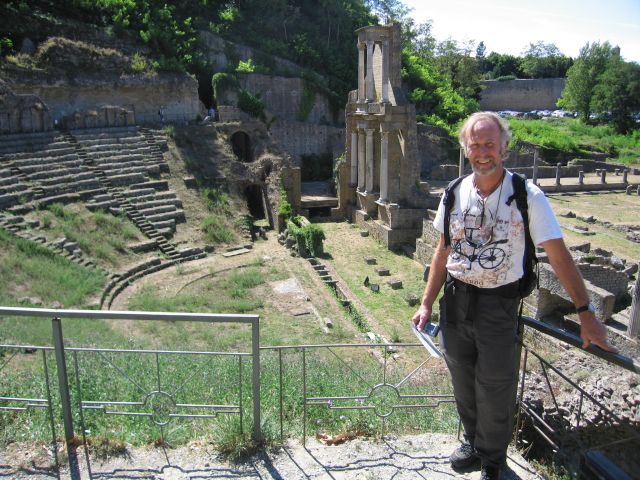A Single Thread
In The |
By Frosty Wooldridge |
The mystique of bicycle travel fascinates most people. Why would anyone “endure” the pains of providing their own locomotion via pedaling rather than the comfort and speed of a car, boat, plane or train? The answer lies in the antiquity of “pedaling bliss.” It thrives in the meshing of your energy with the vivacity of the universe. It rushes into the secret corners of your mind to explore the world on your own terms. Too much comfort leads to tedium or the indolence of life. Once you swing your leg over the saddle of a bicycle, a whole new mental, physical and spiritual dimension opens to every cell in your body. You “fly” at the “perfect speed” with a comet’s tail of memories following you into eternity.
(Standing in the ruins of a walled-city in Tuscany.)
On a recent bicycle tour through the enchanting history of Europe, my friend Gary and I sweated our way into the Italian Alps. We pushed our bikes around hairpin curves, through boreal forests and across mountain ramparts. At Spluggin Pass, we coasted 37 kilometers along a winding, violently descending mountain road that carried us through dark tunnels that led into bright sunshine and flowery Italian meadows.
Ancient Roman ruins dotted the landscape. At lower elevations, 1,000-year-old stone homes housed farmers who worked the land. At the bottom of the Alps, we entered Lago Como (Lake Region) for a ride south into the enchanting land known as Tuscany. If you watched the movie “Under the Tuscan Sun” with Diane Lane, you felt the romance of that vineyard-filled region of fine wines and superb dining.
When you travel through Italy, you travel back in time to walled-cities that protected their inhabitants from the constant charges of competing armies from other towns. Whether you travel through Sienna, Cali-val- Delsa, Florence, Naples or Rome—all those cities once featured or still maintain thickly layered brick ramparts surrounding their main living and commerce areas. And always, each walled-city features an ancient, marble church with tapestries, paintings, stained glass windows and stunning architecture.
One night, we pedaled through a hilly region of Tuscany until we reached a river with a hill that swept upward.
“Let’s bed down up on that ridge after we take a bath in the river,” said Gary. “Roger that,” I said.
Upon washing the day’s grime off our bodies, we walked the bikes up the hill about 150 feet above the highway to a flat spot. We pitched the tents, cooked dinner and watched the night sky reveal millions of twinkling stars.
Next morning, we pedaled along the same road until, in the distance, we discovered a walled-city perched high on a hill.
“Let’s check that one out,” said Gary. “I’m with you,” I said.
We pedaled through woods and fields until the road spiraled upward toward massive 150-foot-high brick walls over 1,500 years old. Along the way, we passed a small abandoned chapel where a work crew repaired furniture. We stopped to see old paintings and statues along the church walls. Those repairmen didn’t think much about working with artifacts and antiquities from centuries ago.
Finally, after sweating up the road, we reached the massive 20-foot high wooden gates of the city. They hadn’t been closed for a hundred years or more. Once inside the city, we stopped at a water fountain to fill our bottles and splash cool liquid into our faces. Around us, shopkeepers and patrons walked along the inside of the walls. A few kids pedaled their rusty bikes as they stared at us. About 100 feet from the fountain, a gray, marble cathedral soared toward the sky. At the top, stained glass windows perched atop beautiful carved frescos.
“Do you hear kids singing?” I asked Gary. “Sounds like a children’s choir inside that cathedral with someone playing a guitar,” he said. “Let’s check it out,” I said.
We walked up the marble steps of the church. “Look at these steps,” Gary said. “They’re worn down an inch at least from the centuries of worshipers coming to church. Generation after generation for over 1,500 years. Man, this is living history.”
We entered the church to sit in 1,500-year-old wooden pews that sat 100 people. In the front, about 20 children and a guitar player practiced their songs in Italian. Their young voices mesmerized us.
For the next half hour, children’s voices carried like musical chariots across the inner chamber of that ancient church. The sun shone through the stained glassed windows like colors from a double rainbow. The scent of history permeated every painting. Marble columns rose 150 feet over our heads. A stunning statue of Christ hung from a cross with blood dripping down his hands and body.
For the next 30 minutes, we sat in sublime joy with Italian songs floating through the air. We couldn’t understand the language, yet our hearts and spirits felt their beauty.
While my bicycle carries me into magical moments on this planet, that day in the cathedral with a children’s choir lifting their voices to the heavens must be one of the most sublime moments of my lifetime. Afterwards, we thanked the children with, “Grazia” and “Molto bene” from our limited Italian language talents.
Back into the sunshine of the day, we remounted the bikes for our journey through the enchanting countryside of Tuscany. I thank Gary for his friendship. I thank the children for their voices. I thank my lucky stars to bear witness to the beauty humanity offers in music, spiritual quest and architectural beauty.
We added another thread into the tapestry of our lives.
|
| Donate to Rense.com Support Free And Honest Journalism At Rense.com | Subscribe To RenseRadio! Enormous Online Archives, MP3s, Streaming Audio Files, Highest Quality Live Programs |
